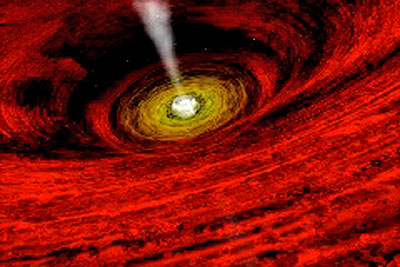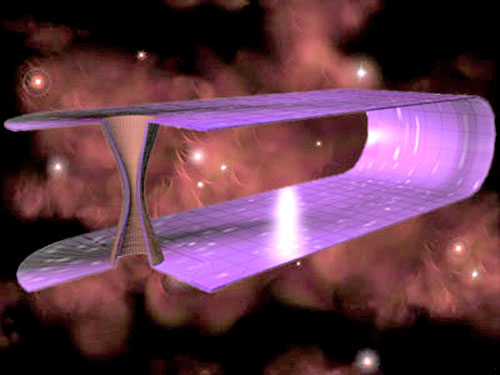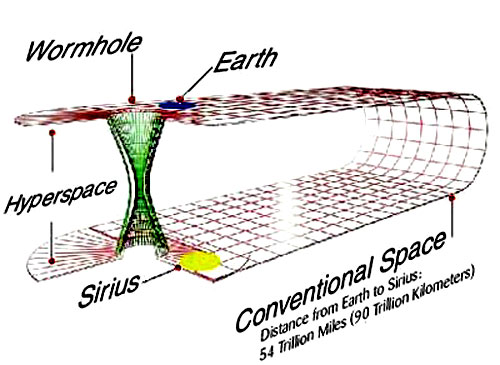|

by Kevin Bonsor
Spanish
version
from
HowStuffWorks Website
There may be no other
concept that captures the imagination more than the idea of time
travel - the ability to travel to any point in the past or future.
What could be cooler? You could jump into your time machine to go
back and see major events in history and talk to the people who were
there! Who would you travel back to see? Julius Caesar? Leonardo da
Vinci? Elvis?
You could go back and
meet yourself at an earlier age, go forward and see how you look in
the future... It's these possibilities that have made time travel
the subject of so many science fiction books and movies.

The dream to travel
through time has existed for centuries.
It turns out that, in
some sense, we are all time travelers. As you sit at your desk,
doing nothing more than clicking your mouse, time is traveling
around you. The future is constantly being transformed into the past
with the present only lasting for a fleeting moment. Everything that
you are doing right now is quickly moving into the past, which means
we continue to move through time.
Ideas of time travel have existed for centuries, but when Albert
Einstein released his theory of special relativity, he laid the
foundation for the theoretical possibility of time travel. As we all
know, no one has successfully demonstrated time travel, but no one
has been able to rule it out either.
In this edition of How Stuff Will Work, we will learn about
the concept of time and the different theories surrounding the
viability of time travel.
Understanding
Time
Astronomer Carl Sagan had it right when he said that time is
"resistant to simple definition." Lots of us think we know what time
is, but it is hard to define. You can not literally see or touch
time, but you can see its effects.
The evidence that we are
moving through time is found in everything - our bodies age,
buildings weather and crumble, trees grow. Most of us feel the
pressure of time as we are pushed to meet deadlines and make
appointments. Our lives are often dictated by what time we need to
be somewhere.
Ask most people to define time and they are likely to look at their
watch or a clock. We see time as the ticking of the hands on these
devices. We know that there are 60 seconds in a minute, 60 minutes
in an hour, 24 hours in a day and 365 days in a year. These are the
basic numbers of time that we all learned in grade school.
Time is also defined as being the fourth dimension of our universe.
The other three dimensions are of space, including up-down,
left-right and backward-forward. Time cannot exist without space,
and likewise, space cannot exist without time. This interconnected
relationship of time and space is called the spacetime continuum,
which means that any event that occurs in the universe has to
involve both space and time.
According to Einstein's theory of special relativity, time slows as
an object approaches the speed of light. This leads many scientists
to believe that traveling faster than the speed of light could open
up the possibility of time travel to the past as well as to the
future.
The problem is that the
speed of light is believed to be the highest speed at which
something can travel, so it is unlikely that we will be able to
travel into the past. As an object nears the speed of light, its
relativistic mass increases until, at the speed of light, it becomes
infinite. Accelerating an infinite mass any faster than that is
impossible, or at least it seems to be right now.
But time travel in the other direction is not as difficult, and the
future may one day be a possible destination...
Black Holes
While writers have produced some great ideas for time machines over
the years, a real-life time machine has yet to be built.
Most theories of time
travel don't rely on machines at all. Instead, time travel will
likely be done by way of natural phenomena that will transport us
instantly from one point in time to another.
These space phenomena,
which we are not even sure exist, include:
-
Rotating
black holes
-
Wormholes
-
Cosmic
strings

Photo
courtesy NASA
When stars that are more
than four times the mass of our sun reach the end of their life and
have burned up all of their fuel, they collapse under the pressure
of their own weight. This implosion creates "black holes," which
have gravitational fields so strong that even light cannot escape.
Anything that comes in contact with a black hole's event horizon
will be sucked in.
The event horizon is the
boundary of a black hole at which nothing can escape.
You can think of the shape of a black hole as similar to an ice
cream cone. It is large on top and tapers into a point, called a
singularity. At the singularity, the laws of physics cease to exist
and all matter is crushed beyond recognition. This kind of
non-rotating black hole is called a Schwarzschild black hole, named
after the German astronomer Karl Schwarzschild.
Another type of black hole, called a Kerr hole, is also
theoretically possible. Kerr holes are rotating black holes that
could be used as portals for time travel or travel to parallel
universes. In 1963, New Zealand mathematician Roy Kerr proposed the
first realistic theory for a rotating black hole. In his theory,
dying stars would collapse into a rotating ring of neutrons that
would produce sufficient centrifugal force to prevent the formation
of a singularity. Since the black hole would not have a singularity,
Kerr believed it would be safe to enter it without being crushed by
the infinite gravitational force at its center.
If Kerr holes do exist, it might be possible to pass through them
and exit out of a "white" hole. A white hole would have the reverse
action of a black hole. So, instead of pulling everything into its
gravitational force, it would use some sort of exotic matter with
negative energy to push everything out and away from it. These white
holes would be our way to enter other times or other worlds.
Given the little we know about black holes, Kerr holes may possibly
exist. However, physicist Kip Thorne of the California
Institute of Technology believes that the laws of physics
prevent such a formation. He says there is no such way to enter and
exit a black hole, and that anything attempting to enter a black
hole will be sucked in and destroyed before it even reaches the
singularity.
We'll take a look at some other space phenomena in the following
sections.
Wormholes
Thorne believes there could be another type of tunnel-like structure
existing in the universe that could be used for a time travel
portal. Wormholes, also called Einstein-Rosen Bridges, are
considered to have the most potential for time travel if they do
exist. Not only could they allow us to travel through time, they
could allow us to travel many light-years from Earth in only a
fraction of the amount of time that it would take us with
conventional space travel methods.
Wormholes are considered possible based on Einstein's theory of
relativity, which states that any mass curves spacetime. To
understand this curvature, think about two people holding a bed
sheet up and stretching that sheet tight. If one person were to
place a baseball on the bed sheet, the weight of the baseball would
roll to the middle of the sheet and cause the sheet to curve at that
point.
Now, if a marble were
placed on the edge of the same bed sheet it would travel toward the
baseball because of the curve.

Imagining space as a
curved, two-dimensional plane,
wormholes like this
could be formed by two masses applying enough force on spacetime
to create a tunnel
connecting distant points in the universe.
In this example, space is depicted as a two-dimensional plane rather
than the four dimensions that actually make up spacetime. Imagine
that this sheet is folded over, leaving a space between the top and
bottom. Placing the baseball on the top side will cause a curvature
to form. If an equal mass were placed on the bottom part of the
sheet at a point that corresponds with the location of the baseball
on the top, the second mass would eventually meet with the baseball.
This is similar to how wormholes might form.
In space, masses that place pressure on different parts of the
universe could eventually come together to form a tunnel -- this is
a wormhole. We could then travel from Earth to another galaxy and
back relatively quickly (within a lifetime). For instance, let's
picture a scenario in which we would want to travel to Sirius, a
star that's seen in the Canis Major constellation just below Orion.
Sirius is about 9
light-years from Earth, which is about 54 trillion miles (90
trillion km).
Obviously, this distance
would be far too great for space travelers to traverse and return in
time to tell us about what they saw there. So far, the farthest
people have traveled into space is to the moon, which is only about
248,548 miles (about 400,000 km) away from Earth. If we could find a
wormhole that connected us to the space around Sirius, then we could
cut the time considerably by avoiding the trillions of miles that we
would have to cross with traditional space travel.
So how does all of this relate to time travel? We'll find out in the
next section.
Cosmic Strings
Yet another theory for how we might travel back and forth through
time uses the idea of cosmic strings, proposed by Princeton
physicist J. Richard Gott in 1991. These are - as their name
suggests - string-like objects that some scientists believe were
formed in the early universe. These strings may line the entire
length of the universe and are under immense pressure - millions
upon millions of tons.
These cosmic strings, which are thinner than an atom, would generate
an enormous amount of gravitational pull on any objects that pass
near them.
Objects attached to a
cosmic string could travel at incredible speeds, and because their
gravitational force distorts spacetime, they could be used for time
travel. By pulling two cosmic strings close together, or one string
close to a black hole, it might be possible to warp spacetime enough
to create closed time-like curves.
A spacecraft could be turned into a time machine by using the
gravity produced by the two cosmic strings, or the string and black
hole, to propel itself into the past. To do this, it would loop
around the cosmic strings. However, there is still much speculation
as to whether these strings exist, and if they do, in what form.
Gott himself said that in order to travel back in time even one
year, it would take a loop of string that contained half the
mass-energy of an entire galaxy.
And, as with any time
machine, you couldn't go back farther than the point at which the
time machine was created.
Time Travel
Physics
As we discussed earlier, the theory of relativity states that as the
velocity of an object nears the speed of light, time slows down.
Scientists have discovered that even at the speeds of the space
shuttle, astronauts can travel a few nanoseconds into the future. To
understand this, picture two people, person A and person B. Person A
stays on Earth, while person B takes off in a spacecraft.
At takeoff, their
watches are in perfect sync. The closer person B's spacecraft
travels to the speed of light, the slower time will pass for person
B (relative to person A). If person B travels for just a few hours
at 50 percent the speed of light and returns to Earth, it will be
obvious to both people that person A has aged much faster than
person B.
This difference in aging
is because time passed much faster for person A than person B, who
was traveling closer to the speed of light. Many years might have
passed for person A, while person B experienced a time lapse of just
a few hours. Find out more about this twin paradox in
How Special
Relativity Works.

Wormholes could allow
you to travel into the past and the future.
If wormholes could be
discovered, it might allow us to travel to the past as well as the
future. Here's how it would work: Let's say the mouth of the
wormhole is portable. Then person B in the example above, who
traveled at 50 percent of light speed into space for a few hours,
could carry one wormhole mouth into space, while the mouth at the
opposite end of the wormhole would stay with person A on Earth.
The two people would
continue to see one another as person B traveled into space. When
person B returned to Earth a few hours later, a few years may have
passed for person A. Now, when person A looks through the wormhole
that traveled into space, that person will see him or herself at a
younger age, the age he or she was when person B launched into
space.
The cool thing about it
is that the older person A would be able to step into the past by
entering the wormhole, while the younger person B could step into
the future.
Problems with
Time Travel
If we are ever able to develop a workable theory for time travel, we
would open up the ability to create very complicated problems called
paradoxes. A paradox is defined as something that contradicts
itself.
Here are two common
examples:
-
Let's say, for the
sake of argument, that you could travel back to a time before
you were born. The mere fact that you could exist in a time
before you were born creates a paradox. If you were born in
1960, how could you exist in 1955?
-
Possibly the most
famous paradox is the grandfather paradox. What would happen if
a time traveler went back and killed one of his or her ancestors
before the traveler was born? If the person killed his or her
grandfather, then how could that person be alive to go back and
kill his or her grandfather? If we could change the past, it
would create an infinite number of paradoxes.
Another theory regarding
time travel brings up the idea of parallel universes, or alternative
histories. Let's say that you do travel back to meet your
grandfather when he was a boy. In the theory of parallel universes,
you may have traveled to another universe, one that is similar to
ours, but has a different succession of events.
For instance, if you
were to travel back in time and kill one of your ancestors, you've
only killed that person in one universe, which is no longer the
universe that you exist in. And if you then try to travel back to
your own time, you may end up in another parallel universe and never
be able to get back to the universe you started in.
The idea here is that every action causes the creation of a new
universe, and that there are an infinite number of universes that
exist. When you killed your ancestor, you created a new universe, a
universe that was identical to your own up until the time you
changed the original succession of events.
Confused yet?
Welcome to the world of
time travel. Just imagine how complicated the ticket prices will be.
|




